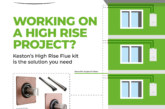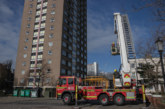
Ashley Clements-Smith, Senior Channel Lead at Honeywell discusses how Arc Fault Detection Devices would provide better protection against electrical fires in domestic properties and answers questions about the current requirements.
According to data from the Home Office, electrically-instigated fires accounted for around 18% of all fires in dwellings between 2010-2020. Considering the potential danger which could result from electrical faults, it has been proposed to make the use of Arc Fault Detection Devices mandatory in AC final circuits in the next amendment to the 18th edition, however a decision on these possible amendments will not be made until early 2022.
When the 18th edition wiring regulations were published in 2018, several changes were made which could affect how circuits are protected, including possible use of Arc Fault Detection Devices (AFDDs). Conditions under which protection against surges in voltage due to lightning were also amended as well as new guidance on the use of specific types of RCD for installations. In anticipation of the second amendment to the regulations, which is currently under consideration, let’s look at potential changes for domestic circuit protection and examine devices that meet the criteria.
Why has it been proposed to make the use of AFDDs mandatory?
An AFDD is an intelligent device that monitors the power system to detect dangerous arcs. These types of arcs could be caused by issues like problematic connections in a faulty piece of equipment, insulation defects in cables, damaged cables or loose terminal connections. Dangerous arcs generate heat and if undetected, they could lead to fires in electrical equipment or the fixed wiring.
When an unsafe arc is detected, AFDDs disconnect the circuit. They are programmed to tell the differences between safe and dangerous arcs so that normal ones such as those caused by switching cycles do not trip the AFDD.
Why does the current 18th edition recommend the use of type A RCDs?
Over the past 50 years, the industry globally has moved away from traditional linear loads from electrical products such as incandescent lighting, to power devices which have switch mode power supplies. Where the former take their power along the whole current wave form so that the load is linear, the latter take different chunks of current out of the sine wave. This distorts the waveform, which causes peaks and troughs.
Type-A Residual Current Devices (RCDs) like those featured on our Metalclad CP can detect DC fault currents whereas type AC RCDs will not.
Although the use of these type-A devices is not mandatory, they are now becoming increasingly specified by consultants and contractors and are recommended in the 18th edition to provide better protection. This means they should be considered for inclusion in a consumer unit when a property uses LED lighting, lighting and heating controls, and appliances such as washing machines, induction hobs, dishwashers and fridges. Type A RCDs as a minimum are mandatory for circuits supplying electric vehicle charging points, so the use of these RCDs in a consumer unit now could also prepare a dwelling for the future.
Are Surge Protection Devices necessary for domestic properties to meet the 18th edition regulations?
When lightning strikes, voltage can be induced onto the local power line, causing a sudden rush of voltage entering properties. A Surge Protection Device (SPD) is designed to absorb this voltage to protect properties and their electrical equipment. It is not mandatory but a recommendation in the 18th edition depending on the probability of lightning strikes in an area. SPDs are offered as an optional extra in the Honeywell Metalclad consumer unit.
Regulations regarding electrical installations are rapidly changing. Over the past decade, there have been three updates to the 17th edition, and the publication of the current 18th edition, which came into effect in 2019. With plans to make a second set of amendments to the wiring regulations, the challenge is for housing providers and specifiers to keep abreast of — or even ahead of — ongoing developments. Deploying advanced technology can provide compliance now and anticipate possible upcoming changes, is helping housing providers to meet electrical safety standards for future installations.








